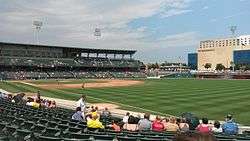Victory Field
 | |
| Location |
501 West Maryland Street Indianapolis, Indiana 46225 |
|---|---|
| Coordinates | 39°45′54″N 86°10′6″W / 39.76500°N 86.16833°WCoordinates: 39°45′54″N 86°10′6″W / 39.76500°N 86.16833°W |
| Owner | Indianapolis Capital Improvement Board |
| Operator | Indianapolis Capital Improvement Board |
| Capacity | Baseball: 12,230 (fixed seats), 14,230 (Lawn + Standing Room) |
| Field size |
Left field - 320 ft Left Center - 418 ft Center Field - 402 ft Right Center - 362 ft Right field - 320 ft |
| Construction | |
| Broke ground | December 16, 1994[1] |
| Opened | July 11, 1996 |
| Construction cost |
$20 million ($30.2 million in 2016 dollars[2]) |
| Architect | Populous (then HOK Sport) |
| Project manager | Geupel DeMars Hagerman[3] |
| Structural engineer | Fink Roberts & Petrie, Inc.[3] |
| Services engineer | Bredson & Associates, Inc.[4] |
| General contractor | Huber, Hunt & Nichols, Inc.[3] |
| Tenants | |
| Indianapolis Indians (IL) (1996–present) | |
Victory Field is a minor league ballpark in Indianapolis, Indiana that is home to the Indianapolis Indians of the International League.
History
Victory Field opened on July 11, 1996 with the Indians falling to the Oklahoma City 89ers 5-3 in front of 14,667 fans. It replaced Bush Stadium, which had also been called Victory Field for some 25 years of its existence.[5] The new park seated 13,300 fans (15,696 with lawn seating) when it was originally opened. However, in 2005, a 1,000 seat bleacher section was removed to make room for a picnic area. The name reflects the victory of the United States in World War II. The opening of Victory Field in 1996 was the catalyst for a revitalization of downtown Indianapolis.[6]

A record 16,168 fans were in attendance on July 22, 2000 to witness the Indians lose to the Columbus Clippers 6-5.[5]
NCAA Division I baseball teams Notre Dame Fighting Irish and Indiana Hoosiers played a game at Victory Field on April 21, 2015.
The IHSAA uses Victory Field for its baseball State Final matches.
Features
Victory Field is considered one of the finest facilities in all of Minor league baseball. It has been recognized as the "Best Minor League Ballpark in America" by Baseball America and Sports Illustrated. Recently, it was ranked #6 by Baseball America in their 2015 survey.[7]
There are currently 12,230 permanent seats and room for approximately 2,000 more fans on the outfield lawn, though on popular days such as the 4th of July, it is not uncommon to total over 15,000 with SRO attendees. Victory Field also features 28 luxury suites, five suite-level party areas, and two large picnic areas.
The seating is broken down as followed:[5]
- Box Seats (Field and View): 7,557
- Reserved Level (Upper and Lower): 3,765
- Lawn: 2,000
- The Coors Light Cove: 125
- Suite level: 543
- Wheelchair: 240
Victory Field shares the limelight with the neighboring Lucas Oil Stadium, Bankers Life Fieldhouse, the Indiana University Natatorium, and the Michael A. Carroll Track & Soccer Stadium.
Seating Capacity
The seating capacity has changed over the year, as follows:
- 13,500, 15,696 with lawn seating (1996–2004)[8]
- 12,500, 14,500 with lawn seating (2005–2010)[9]
- 12,200, 14,200 with lawn seating (2011)[10]
- 12,202, 14,202 with lawn seating (2012)[11]
- 12,230, 14,230 with lawn seating (2013–present)[5]
Improvements
Several changes were made to the ballpark between the 2009 and 2010 seasons. Most notably, crews installed a new HD video display that spans the left field wall and measures 6 1⁄2 feet (2.0 m) tall by 120 feet (37 m) wide. The new digital board, which has the highest resolution (16mm) of any display in Minor League Baseball, features interactive messages, advertisements, and live scores and statistics. The Indians invested approximately $600,000 in the new digital display which was designed by Brookings, South Dakota-based Daktronics.[12]
References
- ↑ "Indianapolis Begins Work On Its New Baseball Stadium". The News-Sentinel. Fort Wayne. December 17, 1996. p. 7S. Retrieved September 16, 2011.
- ↑ Federal Reserve Bank of Minneapolis Community Development Project. "Consumer Price Index (estimate) 1800–". Federal Reserve Bank of Minneapolis. Retrieved October 21, 2016.
- 1 2 3 "Victory Field". Emporis.com. Retrieved September 30, 2011.
- ↑ "Pro Baseball Sports Facilities". Bredson & Associates, Inc. Archived from the original on April 10, 2002. Retrieved August 8, 2013.
- 1 2 3 4 "2014 Indianapolis Indians Media Guide: Victory Field & Media" (PDF). Indianapolis Indians. April 27, 2014. Retrieved May 15, 2014.
- ↑ "Indianapolis' Nationally Lauded Downtown Renaissance Continues". Indianapolis Downtown Inc. Retrieved May 15, 2014.
- ↑ Schoettle, Anthony (June 3, 2015). "Victory Field keeps pace with newer, more expensive venues". ibj.com. Indianapolis Business Journal. Retrieved August 19, 2015.
- ↑ "Downtown Stadium Should Be Pursued". Louisville Business First. October 7, 1996. Retrieved May 15, 2014.
- ↑ "2007 Indianapolis Indians Media Guide" (PDF). Indianapolis Indians. April 7, 2007. p. 130. Retrieved May 15, 2014.
- ↑ "2011 Indianapolis Indians Media Guide" (PDF). Indianapolis Indians. April 5, 2011. p. 192. Retrieved May 15, 2014.
- ↑ "2012 Indianapolis Indians Media Guide" (PDF). Indianapolis Indians. April 27, 2012. p. 154. Retrieved May 15, 2014.
- ↑ "Indians Add New Video Board At Victory Field". Our Sports Central. Indianapolis Indians. April 5, 2010. Retrieved February 15, 2013.
External links
| Wikimedia Commons has media related to Victory Field. |
- Info from the official site
- Ballpark Digest's Visit to Victory Field
- Victory Field Views - Ball Parks of the Minor Leagues
| Events and tenants | ||
|---|---|---|
| Preceded by Bush Stadium |
Home of the Indianapolis Indians 1996 – present |
Succeeded by current |